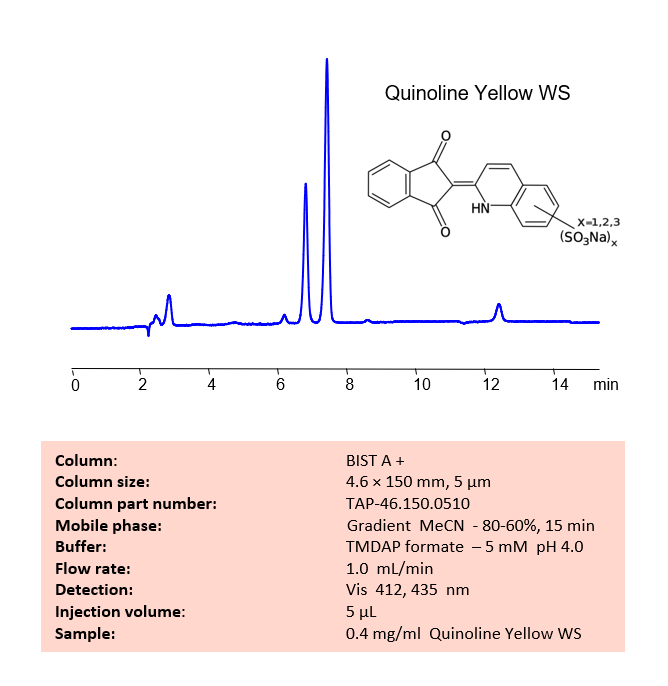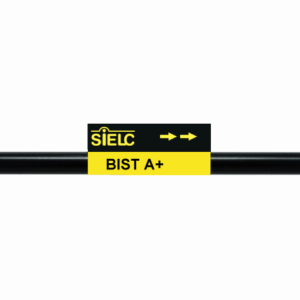Applications:
HPLC Method for Analysis of Quinoline Yellow WS on BIST A+ Column by SIELC Technologies
November 29, 2022
HPLC Method for Analysis of Quinoline Yellow WS on BIST A+ Column by SIELC Technologies
Separation type: Bridge Ion Separation Technology, or BIST™ by SIELC Technologies

High Performance Liquid Chromatography (HPLC) Method for Analyses of Quinoline Yellow WS BIST A+ Column by SIELC Technologies
Quinoline Yellow WS (E104, D&C Yellow 10) is a mixture of 3 different derivatives of Quinoline Yellow SS, consisting of monosulfonates, (mostly) disulfonates, and trisulfonates. The dye is typically neon-yellow (yellow with a hint of green). Using SIELC’s newly introduced BIST™ method, Quinoline Yellow WS can be retained and separated into its component compounds easily on a negatively-charged, cation-exchange BIST™ A+ column. There are two keys to this retention method: 1) a multi-charged, positive buffer, such as N,N,N’,N’-Tetramethyl-1,3-propanediamine (TMDAP), which acts as a bridge, linking the negatively-charged anion analytes to the negatively-charged column surface and 2) a mobile phase consisting mostly of organic solvent (such as MeCN) to minimize the formation of a solvation layer around the charged analytes. Other positively-charged buffers that can generate BIST™ include DMP, Calcium acetate, and Magnesium acetate. Using this new and unique analysis method, Quinoline Yellow WS can be retained and separated with high selectivity and great peak shape. This method can be detected and is compatible with ELSD, CAD, and Mass Spectrometry (LC-MS).
Condition
| Column | BIST A+, 4.6×150 mm, 5µm, 100A |
| Mobile Phase | Gr MeCN – 80-60%, 15 min |
| Buffer | TMDAP formate – 5 mM pH 4.0 |
| Flow Rate | 1.0 ml/min |
| Detection | VIS 412 nm |
Description
| Class of Compounds | Dye |
| Analyzing Compounds | Quinoline Yellow WS |
Application Column
BIST A+
BIST™ columns offer a unique and effective way to achieve separations that were traditionally challenging or even impossible with other HPLC columns. With the use of a special mobile phase, these ion exchange columns provide very strong retention for analytes with the same charge polarity as the stationary phase, unlocking new chromatography applications. What makes BIST™ columns stand out is their proprietary surface chemistry, which results in superior selectivity, resolution, and sensitivity. These columns offer a simple, efficient solution for a variety of analytical challenges, making them an excellent choice for researchers and analysts across many different fields. To learn more about the technology that powers BIST™ columns and to explore related applications, check out https://BIST.LC.
Select options


